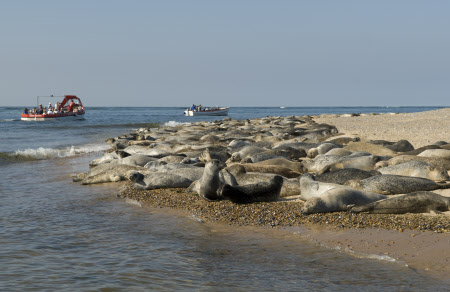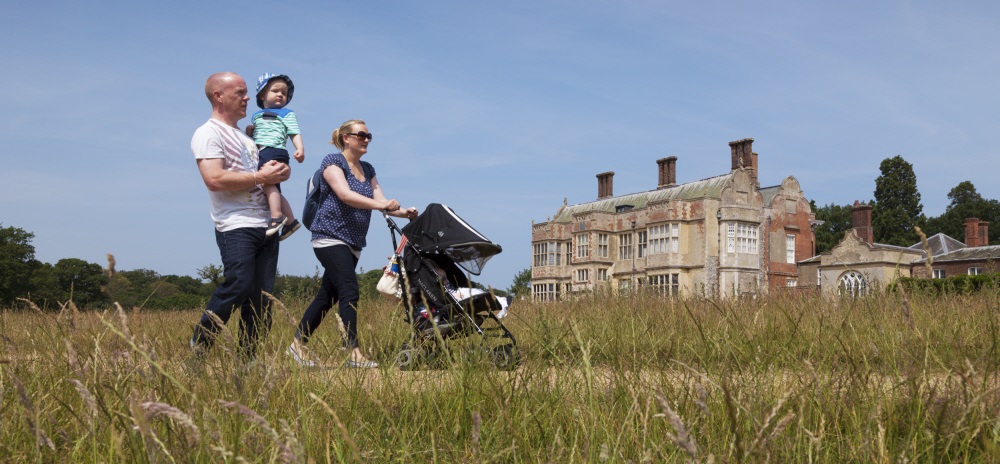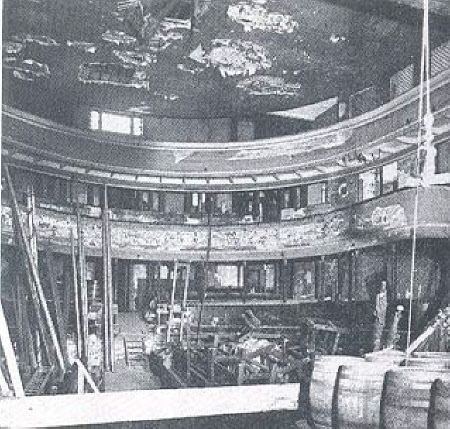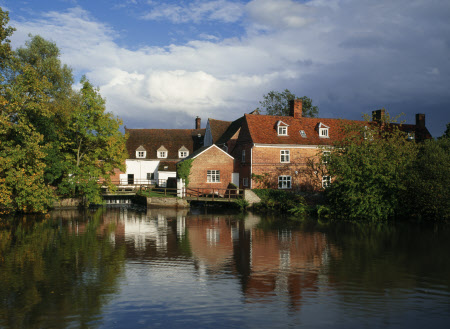-
Mémoires of an East Anglian Land Agent, by Oliver Maurice, Hon Director INTO
Posted on July 16, 2015For those coming to ICNT 16 in Cambridge I thought it might be of interest to have a little background from my personal experience of managing some of the NT properties that we will be visiting as part of the Conference itself and also, for those coming early or staying on afterwards, other NT properties in the Region which they may wish to visit.

A boat from Morston Quay brings visitors to see the seal colony of up to 5,000 common and grey seals at Blakeney Point, Norfolk.
After a 6 month stint in Head Office in 1970 as a ‘baby agent’ learning the ropes and meeting the ‘top brass’, I was posted to the NW Region as an Assistant Land Agent. I spent four and a half years there before being invited to take up the vacant position of Land Agent (one of three) in the East Anglia Region which then comprised Norfolk, Suffolk and Cambridgeshire.
Coming from the Lake District to Norfolk where I lived during my 9 years in the region, could not have been a greater contrast in terms of landscape, topography and people. Whereas I was attuned to looking at fells (mountains), ranging in height from 2000 – 4000 feet , and lakes and managing Herdwick sheep farms and their tenants, I was now in a county in which the highest point was 250 feet above sea level! I lived on a ‘hill’ which was 25 feet above the surrounding landscape with stunning views which went on forever!
The properties were divided amongst us and I was lucky enough to be allocated the North Norfolk coast and Felbrigg and most of the properties in Suffolk, including Ickworth, Melford Hall, Lavenham Guildhall, Flatford Mill and the Theatre Royal in Bury St Edmunds.
It was quite a portfolio, infinitely varied and with some huge challenges as I am sure there still are today.
The North Norfolk coast is magical – very flat (of course!) with wonderful saltmarshes and an amazing flora and fauna particularly seabirds as well as the largest colony of grey seals in England on Blakeney Point, which is a must for any visitor to those parts.
Further west lies the attractive harbour at Brancaster Staithe, the access point for Scolt Head Island, and a little further on, the long beach at Brancaster. I remember well serving as secretary to the Brancaster Harbour Management Committee which, in those days, was chaired by Vice Admiral Sir Hector MacLean who usually took the meetings with his pet parrot on his shoulder. When it was not on his shoulder any member of the committee was in danger of a sharp bite on the ear, which had the effect of keeping us all on our toes !

Visitors walking outside at Felbrigg Hall, Gardens and Estate, Norfolk. Felbrigg Hall is one of the finest 17th-century country houses in East Anglia.
Felbrigg Hall, not far from the north coast is a hidden gem. In a rural location this beautiful house and walled garden, with a lake and extensive woodlands, provides something for everybody. My predecessor as managing agent told me that he once saw a ghost in the library, but try as I might, I never did!
Ickworth was perhaps the most challenging of all the properties I looked after. At that time the East Wing was occupied by Earl Jermyn, who subsequently inherited the title of Marquess of Bristol on the death of his father. Both were notorious in their time for different reasons. Lord Jermyn was not an easy man to deal with and would delight in keeping one waiting for anything up to two hours for a meeting. The only compensating factor was that his butler would ply one with gin and tonic though the downside was that one’s negotiating skills were somewhat reduced by the time the meeting took place!Another habit of his Lordship was to buzz visitors just as they were arriving at the main entrance to the house. A large American Jeep type vehicle would come hurtling down the long drive and do a quick turn at the entrance spraying unsuspecting visitors with fine gravel! It was never easy to ask him to behave more reasonably.

View from beyond the Canal showing the lake, walled garden, summer house, St Mary’s church and Rotunda at Ickworth, Suffolk. St Mary’s church is owned and under the care of the Ickworth Church Conservation Trust.
In the walled garden at Ickworth there used to be a rain gauge and the rainfall was meticulously recorded daily and had been since 1908. Between that year and my spell as managing agent in the late 70’s and early 80’s the annual rainfall had only varied between 25 and 30 inches, never less and never more. It will be interesting to discover if records are still kept and whether the change of climate has affected the levels.
The Theatre Royal at Bury St Edmunds was another property in my portfolio. During my time the Theatre Management Committee carried out the first restoration – it had previously been used as a barrel store by the neighbouring Greene King brewery. The result was amazing and certainly breathed new life into the building. I remember attending a marvellous concert by a New Orleans Jazz band, Preservation Hall, which seemed an appropriate title, and ended with the audience dancing on the stage to their signature tune « When the Saints Go Marching In » !
While not directly responsible for the management of Wimpole Hall I do recall participating in the official opening by Her late Majesty Queen Elizabeth, The Queen Mother. She was famously known for enjoying a gin and tonic which might have had something to do with the small faux pas she made when declaring « Wimpall Hole open »!!
Lavenham Guildhall in the village of Lavenham with over 300 buildings of historic interest is a wonderful example of a cruck beam timber-framed building and arguably the best of its kind. Lavenham’s prosperity in the early part of the 16th century was due the wool industry and in particular the woad-dyed broadcloth known as Lavenham Blues which was exported far and wide.
Today Lavenham is one of the best preserved medieval villages in Britain and definitely worth a visit.
Not far away is Long Melford with Melford Hall close to the village centre. It was always a pleasure to visit this property as the agent and meet with the Hyde Parkers’ whose family have lived there for generations and still do. I mostly had dealings with Sir Richard but his mother who was alive in those days, I met from time to time and listened avidly to her stories of the visits to Melford by Beatrix Potter, a cousin of Sir Richard’s Grandmother, Lady Ethel. Today there is a room dedicated to Beatrix Potter displaying some of her watercolours and soft toys that she used as models for her paintings. I remember being thrilled to hold Jemima Puddleduck on one occasion when I visited!
For those who love John Constable’s landscape paintings you have to include the Dedham Vale and Flatford Mill in particular. Little has changed from his famous Hay Wain painting with the River Stour and Willy Lott’s cottage in the background; and the Mill itself is much as it was when Constable painted it.
A building adjacent to the mill was in a prime strategic position to be acquired by the Trust in order to establish a much needed tea room for visitors. However it was owned by two elderly and apparently fierce spinsters and nobody had dared to approach them. On one occasion I happened to bump into them and plucked up courage to ask if they would be prepared to sell. Much to my surprise they were all sweetness and light and more or less agreed on the spot. After a little further negotiation we agreed a price and, as far as I am aware, the tearoom exists to this day!
I sincerely hope you will have the opportunity to visit some of these wonderful properties that the National Trust protects and preserves for ever, for everyone.

 44 (0)20 7824 7157
44 (0)20 7824 7157
